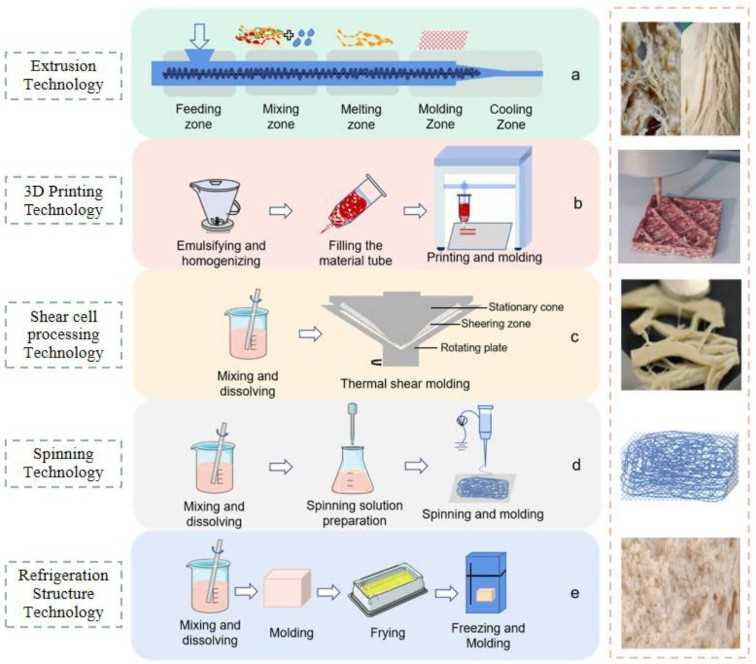The plant-based meat industry is growing rapidly and offers tremendous opportunities for food developers and manufacturing companies. The manufacturing of plant-based meats involves at least three key points, namely creating the meat-like structure, and creating the meat-like appearance and taste. Animal skeletal muscle has a complex hierarchical structure composed of fibrous protein bundles. In contrast, most plant proteins are globular, which makes it challenging to replicate animal fibrous muscle structures using natural plant proteins. Plant proteins must typically be denatured and unfolded before they can be aligned and cross-linked to create plant flesh. Therefore, it is critical to developing technologies that give ground to plant proteins. The desired texture of the final plant-based meat product depends on the type of conventional meat to be replicated.
 Fig.1. Processing principle, process flow and finished product diagram of different molding technologies of plant-based meat. (Zhao D, et al., 2022)
Fig.1. Processing principle, process flow and finished product diagram of different molding technologies of plant-based meat. (Zhao D, et al., 2022)
Characterizing muscle tissues consisting of muscle fibers, connective tissue, and adipose tissue in a complex, layered system with viscoelastic structural characteristics has proven challenging. The physicochemical and sensory properties of traditional meats depend heavily on the structural arrangement of these tissues. Lifeasible's team of food scientists and application development experts are dedicated to developing plant-based protein mechanical texturization methods that allow plant-based meats to reproduce traditional meats in terms of physical sensory (appearance, texture, taste, odor, etc.).
Lifeasible is a leading partner in the manufacturing of plant-based meat. We offer a variety of plant-based meat texturing solutions to easily achieve the proper texture extension of plant proteins similar to that of meat. Whether your plant protein originates from legumes or algae, we develop the right strategy to create plant-based texturized meats afterward. Our strategies include, but are not limited to:
"Top-Down" Texturing Strategies, where external forces are applied to build the biopolymer blend.
"Bottom-Up" Texturing Strategies, where the structural components of the fibers are assembled to build the final product.
We design texturized plant-based proteins that contain three different structures: fibrils, capillary-filled gels, or fibril-filled gels. The nature of their final structure depends heavily on the properties of the components, such as their water-binding ability and rheological properties.
We provide sustainable texturized plant-based proteins to accelerate your plant-based meat production. These solutions are widely used by food developers and manufacturing companies worldwide to create the following plant-based meats.
❖ Chicken
❖ Pork
❖ Fish and shrimp
❖ Beef
❖ Eggs
❖ Dairy products
We develop sustainable strategies to build plant-based proteins with fibrous structures. As an ideal partner, Lifeasible has cutting-edge technology, state-of-the-art methods, and innovative solutions to support your brand in various end-use applications. We help you bring innovative products to market to meet the growing consumer demand for plant-based meats. Feel free to contact us for more information.
Reference